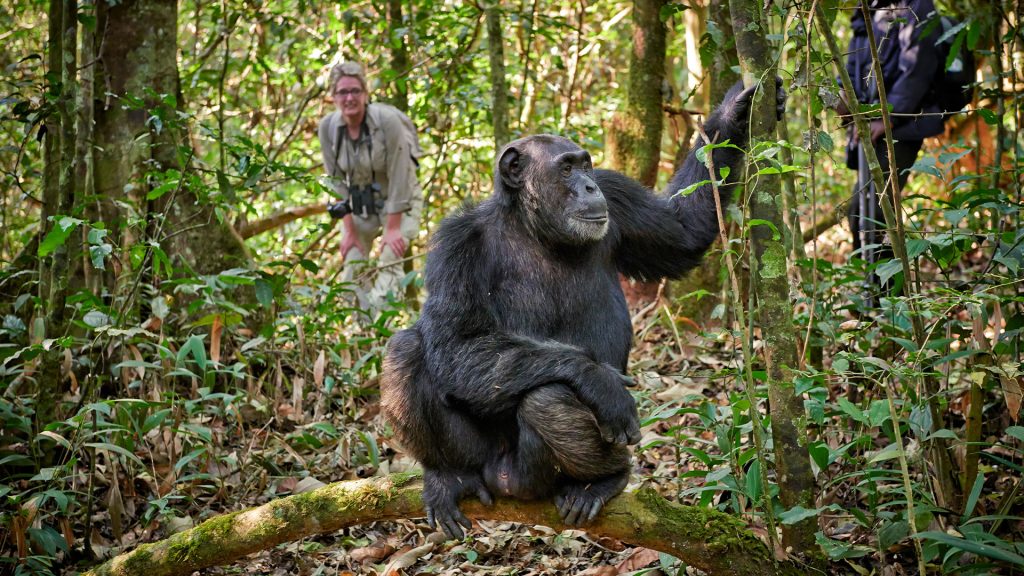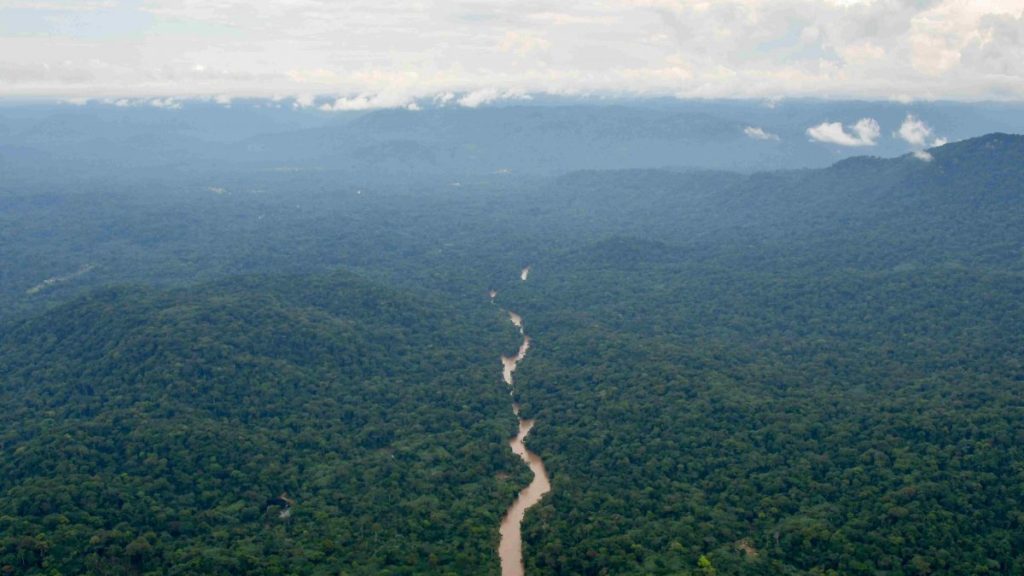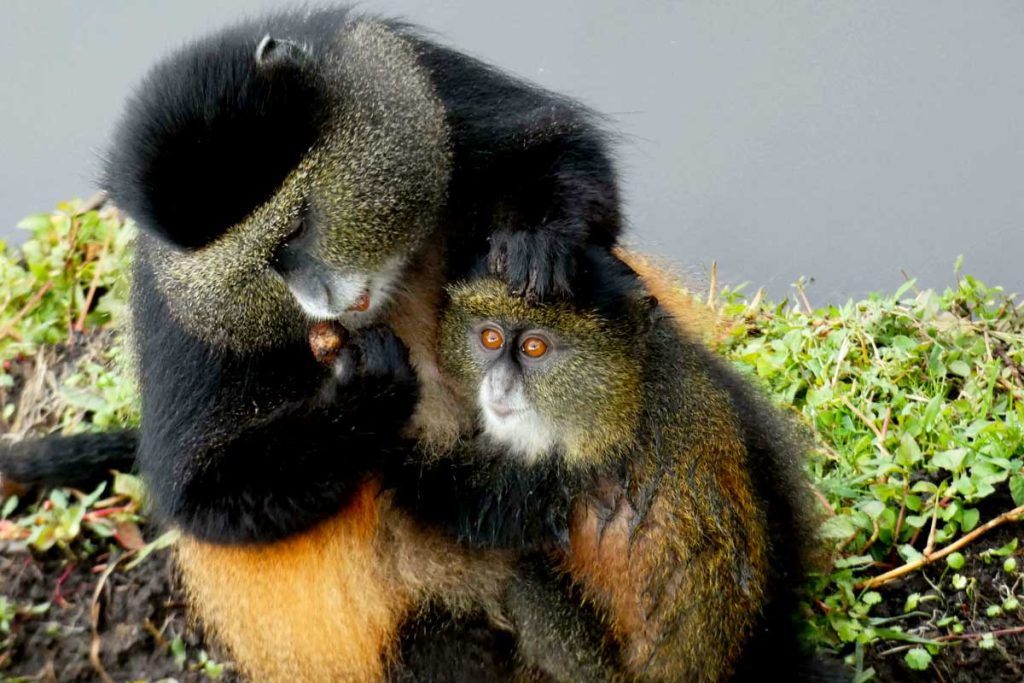Gishwati Mukura National Park
- Updated: 6 months ago
- By Editorial Team
Gishwati Mukura National Park – Rwanda, Chimps & More
Gishwati Mukura National Park feels like a secret. A soft one, not known to all. The kind only nature can keep for centuries. Trees arch overhead like they’re sheltering something sacred.
Moss hugs every trunk, and the ground beneath your boots is so rich and alive you swear you can feel it breathe. Birds call out like morning prayers. Somewhere in the canopy, a monkey rustles a branch, curious but shy.
A visit to Gishwati Mukura is more rewarding than you may think.
Gishwati Mukura Safari activities (Why visit Gishwati Mukura )
Chimpanzee Encounters: Rwanda’s Shy Cousins in the Trees
They’re not easy to find, but that’s the beauty of it. Chimpanzees in Gishwati live in smaller families than those in Nyungwe, but they move through the trees with the same ancient grace, zeal and spirit.
Your guide, walking softly ahead, listens for clues—broken branches, distant calls, a sudden hush in the bird chorus.
The forest is dense here. Not intimidating, but intimate. You’ll brush past young fig saplings, step carefully across root systems older than most cities, and stop every so often to listen. And then, you hear it. A pant-hoot. A rustle. A flick of black fur between the vines.
The chimps watch you as much as you watch them. One swings lower, eyes alert and thoughtful. A mother nurses her infant in a cradle of limbs. There’s no rush. No crowd. Just the forest, the chimps, and you—drawn together in a moment that feels both wild and deeply familiar.
Golden Monkeys & Other Forest Surprises
Golden monkeys of Gishwati are stubborn and may be seen on the way laughter dancing through a family gathering—quick, bright, and impossible to miss.
Their amber-gold fur glows when a sunbeam slips past the leaves, as if Imana (God) brushed them with liquid light. They’ll stare at you for half a heartbeat—big curious eyes, head tilted—then zip away in a blur of fur and rustling branches. They never stick around long, yet somehow they leave joy trailing behind, like the echo of a good joke.
Lower in the trees, you can find the L’Hoest’s monkeys—grey coats, neat white beards—huddle in little circles, gently picking through each other’s fur as if sharing secrets. Nearby, blue monkeys lounge in the shade, soft-eyed and unrushed, nibbling fruit or simply watching the world go by. They don’t clamour for attention; they invite it. Give them a patient look, and the forest feels suddenly full of gentle company.
That’s the magic here. You don’t chase wildlife in Gishwati; you stroll. You listen to leaves whisper “turakomeye” (we are strong) in the breeze, and the forest decides what gifts to share. Even when everything seems still, life is tucked into every branch and shadow—waiting, watching, always close enough to find if you move slowly and let wonder lead the way.
Birdwatching & Guided Walks: The Forest That Sings Back
With over 230 bird species recorded, Gishwati’s forest is never quiet. It hums. It sings. It clicks and whistles and echoes with songs that seem to come from everywhere at once. Your guide might name them—Grauer’s swamp warbler, Ruwenzori batis, grey crowned crane—but honestly, you don’t need the names to feel the magic. Just listen. Let the birds do the rest.
Take a guided nature walk and the park opens its heart. Learn about indigenous trees and their uses—like Umushinshi, used to treat coughs, or the sacred umuvumu fig tree, where elders once gathered to make decisions. Every leaf here carries a story. Every step takes you deeper into something more than wilderness—it feels like walking into memory.
Gishwati Mukura National Park Gallery
When to Visit Gishwati Mukura
Gishwati Mukura may be visited anytime of the year, but like most of Rwanda’s natural treasures, her mood shifts with the seasons.
June to September is the long dry season. Trails are easier to navigate, and visibility is clearer for primate watching. The light is crisp. The air carries a touch of mountain coolness. It’s perfect for photography and peaceful forest hikes and definitely, the most recommended time to visit Gishwati Mukura National park.
December to February is another calm window. The forest is green but not soaked, the sun gentle on your shoulders, and the primates more active in the mornings. These months suit travelers who love quiet trails and fewer visitors.
March to May and October to November bring rain—but with it, life. The forest glows brighter, moss thickens, and flowers bloom in places you didn’t expect. The trails may be muddy, but you’ll likely have them to yourself. For travelers who like their nature wild and unscripted, this is the season of quiet wonders.
Gishwati Mukura’s Location
Gishwati Mukura National Park lies in the Western Province of Rwanda, between Rubavu (Gisenyi) and Karongi (Kibuye), just off the road that links Lake Kivu’s northern and southern shores. It’s a perfect stopover on the Congo Nile Trail or as a soft breath between Nyungwe and Volcanoes National Park.
The park is made up of two separate forests—Gishwati and Mukura—once badly degraded but now protected, restored, and slowly reconnecting. The Gishwati sector is the most accessible and currently open to visitors, just two hours from Rubavu or about four hours from Kigali. The drive winds through some of Rwanda’s most breathtaking countryside—tea fields, terraced hills, and quiet homesteads with curious smiles waiting at the gate.
History of Gishwati Mukura
Gishwati’s story dates back up to the 1994. After the 1994 Genocide against the Tutsi, displaced communities sought shelter in the forest, and deforestation followed. Over decades, the forest shrank by more than 90%. Wildlife vanished. Rivers dried. But the story didn’t end there.
Fortunately, in 2015, the Rwandan government, together with local communities and conservation partners, declared it a National Park—the fourth in the country. Restoration began. Trees were planted. Wildlife returned. Today, Gishwati Mukura is a symbol not just of Rwanda’s environmental commitment, but of its heart: one that rebuilds, one that forgives, and one that believes healing is possible.
Gishwati Mukura Accommodations
There are no luxury lodges inside Gishwati yet—but that’s part of the charm. You come here for simplicity. For peace. For nights where stars outnumber electric lights.
Gishwati Lodge (Upcoming) is in development and will soon offer eco-luxury in the heart of the forest, perfect for travelers seeking high-end comfort with conservation impact.
For now, Gisenyi and Kibuye serve as your best basecamps—both just a few hours away and home to some of Rwanda’s most charming lakeside stays.
In Gisenyi, unwind at Lake Kivu Serena Hotel or go rustic at Paradise Malahide, where boats bob just beyond your room and grilled tilapia is served with soft music and a smile.
In Kibuye, Cormoran Lodge and Moriah Hill Resort offer lake views, sunset decks, and easy access to nearby forest reserves.
Not sure which direction suits you best? Friendly Gorillas Safaris knows every trail, lodge, and roadside view. They’ll help you pair your forest time with rest that matches your spirit—simple, soulful, or something in between.
Frequently Asked Questions
Can I trek chimpanzees in Gishwati?
Yes—but keep your expectations tender. The chimpanzee group here is smaller and more elusive than in Nyungwe, making sightings rarer but often more intimate. On some days, you’ll catch glimpses. On others, you’ll simply follow their tracks—and feel their presence all the same.
What makes Gishwati different from Nyungwe?
Gishwati is smaller, quieter, and less visited. While Nyungwe dazzles with size and infrastructure, Gishwati offers closeness. Fewer people. Closer wildlife. A sense that the forest is still remembering itself—and allowing you in as a gentle guest.
Is it suitable for families?
Absolutely. Guided nature walks, birdwatching, and short forest hikes are perfect for children with a love for the outdoors. It’s a peaceful introduction to Rwanda’s biodiversity—less intense, but no less rewarding.
What do I need to pack?
Comfortable walking shoes, long sleeves and trousers, insect repellent, a reusable water bottle, and a rain jacket—regardless of season. Bring binoculars for birdwatching and a curious heart for everything else.
Are there cultural experiences nearby?
Yes. Nearby communities welcome visitors to learn traditional dance, crafts, and agroforestry practices. You can even join in tree planting activities—leaving behind more than just footprints.
Can I visit without a guide?
Guides are required for forest entry and enhance the experience deeply. Many are from the local communities and know every bird call, animal track, and tree by name. They don’t just guide—they share.
How long should I stay?
Spend at least a full day in the forest—long enough to breathe it in and feel its pace. Two nights is even better if you’re connecting it to Lake Kivu or traveling the Congo Nile Trail. With Friendly Gorillas Safaris, you can build a gentle itinerary that leaves space for wonder.
Conclusion
Gishwati Mukura is the kind of place you feel with your whole body—the damp air on your neck, the press of leaves beneath your boots, the quiet flicker of a bird through the trees. It’s not about ticking off animals or collecting photos. It’s about arriving, listening, and letting go.
Come walk its mossy paths. Come trace the recovery of a forest and a people. Let Friendly Gorillas Safaris guide you into Rwanda’s softest wilderness, where every step forward is a whisper back to nature.
Because some places don’t ask for your attention. They invite your presence. Gishwati Mukura is one of them.










